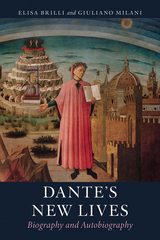210 books about Homes and haunts and 4
start with U
210 books about Homes and haunts and 4
210 books about Homes and haunts
4 start with U start with U
4 start with U start with U
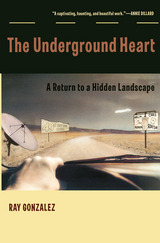
The Underground Heart
A Return to a Hidden Landscape
Ray Gonzalez
University of Arizona Press, 2002
Returning home after a long absence is not always easy. For Ray Gonzalez, it is more than a visit; it is a journey to the underground heart. He has lived in other parts of the country for more than twenty years, but this award-winning poet now returns to the desert Southwest—a native son playing tourist—in order to unearth the hidden landscapes of family and race.
As Gonzalez drives the highways of New Mexico and west Texas, he shows us a border culture rejuvenated by tourist and trade dollars, one that will surprise readers for whom the border means only illegal immigration, NAFTA, and the drug trade. Played out against a soundtrack of the Allman Brothers and The Doors, The Underground Heart takes readers on a trip through a seemingly barren landscape that teems with life and stories. Gonzalez witnesses Minnesotans experiencing culture shock while attending a college football game in El Paso; he finds a proliferation of Pancho Villa death masks housed at different museums; he revisits Carlsbad Caverns, discovering unsuspected beauty beneath the desert's desolation; and he takes us shopping at El Mercado—where tourists can buy everything from black velvet paintings of Elvis (or Jesus, or JFK) to Mexican flag underwear.
From "nuclear tourism" in New Mexico to "heritage tourism" in the restored missions of San Antonio, Gonzalez goes behind the slogans of The Land of Enchantment and The Lone Star State to uncover a totally different Southwest. Here are tourist centers that give a distorted view of southwestern life to outsiders, who leave their dollars in museum gift shops and go home weighed down with pounds of Indian jewelry around their necks. Here border history is the story of one culture overlaid on another, re-forming itself into a whole new civilization on the banks of the Rio Grande.
The Underground Heart is a book brimming with subtle ironies and insights both quiet and complex—one which recognizes that sometimes one must go away and grow older to finally recognize home as a life-giving, spiritually sustaining place. As Gonzalez rediscovers the land of his past, he comes to understand the hyper, bilingual atmosphere of its future. And in the Southwest he describes, readers may catch a glimpse of their own hidden landscapes of home.
As Gonzalez drives the highways of New Mexico and west Texas, he shows us a border culture rejuvenated by tourist and trade dollars, one that will surprise readers for whom the border means only illegal immigration, NAFTA, and the drug trade. Played out against a soundtrack of the Allman Brothers and The Doors, The Underground Heart takes readers on a trip through a seemingly barren landscape that teems with life and stories. Gonzalez witnesses Minnesotans experiencing culture shock while attending a college football game in El Paso; he finds a proliferation of Pancho Villa death masks housed at different museums; he revisits Carlsbad Caverns, discovering unsuspected beauty beneath the desert's desolation; and he takes us shopping at El Mercado—where tourists can buy everything from black velvet paintings of Elvis (or Jesus, or JFK) to Mexican flag underwear.
From "nuclear tourism" in New Mexico to "heritage tourism" in the restored missions of San Antonio, Gonzalez goes behind the slogans of The Land of Enchantment and The Lone Star State to uncover a totally different Southwest. Here are tourist centers that give a distorted view of southwestern life to outsiders, who leave their dollars in museum gift shops and go home weighed down with pounds of Indian jewelry around their necks. Here border history is the story of one culture overlaid on another, re-forming itself into a whole new civilization on the banks of the Rio Grande.
The Underground Heart is a book brimming with subtle ironies and insights both quiet and complex—one which recognizes that sometimes one must go away and grow older to finally recognize home as a life-giving, spiritually sustaining place. As Gonzalez rediscovers the land of his past, he comes to understand the hyper, bilingual atmosphere of its future. And in the Southwest he describes, readers may catch a glimpse of their own hidden landscapes of home.
[more]
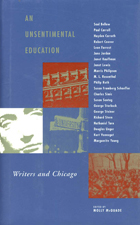
An Unsentimental Education
Writers and Chicago
Molly McQuade
University of Chicago Press, 1995
"Writers are both born and made, and their teachers share in the making of them, but in what ways?" Molly McQuade asks in An Unsentimental Education, a collection of candid interviews with twenty-one of our leading novelists and poets. Presented as first-person essays, the interviews are with contemporary writers who have studied, taught at, or cultivated other ties with the University of Chicago. The book provides an occasion for the writers to reflect on their Chicago experiences and on ideas about education in general. What education does a writer need? How can formal learning impel the writing life? What school stories or tales told out of school do Philip Roth, Hayden Carruth, Marguerite Young, George Steiner, Charles Simic, Susan Sontag, and Saul Bellow have in store and want to share.
Interviews with:Saul Bellow, Paul Carroll, Hayden Carruth, Robert Coover, Leon Forrest, June Jordan, Janet Kauffman, Morris Philipson, M. L. Rosenthal, Philip Roth, Susan Fromberg Shaeffer, Charles Simic, Susan Sontag, George Starbuck, George Steiner, Richard Stern, Nathaniel Tarn, Douglas Unger, Kurt Vonnegut, and Marguerite Young.
Interviews with:Saul Bellow, Paul Carroll, Hayden Carruth, Robert Coover, Leon Forrest, June Jordan, Janet Kauffman, Morris Philipson, M. L. Rosenthal, Philip Roth, Susan Fromberg Shaeffer, Charles Simic, Susan Sontag, George Starbuck, George Steiner, Richard Stern, Nathaniel Tarn, Douglas Unger, Kurt Vonnegut, and Marguerite Young.
[more]
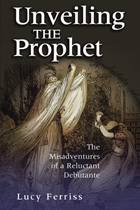
Unveiling the Prophet
The Misadventures of a Reluctant Debutante
Lucy Ferriss
University of Missouri Press, 2005
In the autumn of 1972, Lucy Ferriss, then a college student in California, was preparing for the Veiled Prophet Ball at which she was to be presented to St. Louis society. Once the largest cotillion in the country, the invitation-only ball was unique among society events not only for the legend and mystery surrounding its namesake but also for its setting in a public, taxpayer-funded arena and for its accompanying parade.
In the late sixties and early seventies, with racial tensions at a boiling point and urban renewal failing, the exclusively white male Christian membership of the Veiled Prophet Society and the Veiled Prophet’s costume—eerily reminiscent of a Klansman’s—attracted the ire of ACTION, a militant civil rights group. Before the 1972 ball, ACTION founder Percy Green, himself a native St. Louisan, sent letters inviting all of the debutantes to join in the protest: “ACTION understands that you hate being part of this upcoming white racist Veiled Prophet Ball as we hate you being forced to participate by your parents.” The letter didn’t persuade Ferriss, who felt she owed it to her father to participate. She wrote back: “Don’t you have bigger fish to fry? This is just a stupid party. We are slaughtering people in Southeast Asia. Let this one go. It will fall of its own weight.”
But ACTION did not let this one go. On the night of the ball, as Ferriss bowed in obeisance to the crowd and took her place on the stage, a woman swooped down onto the stage and knocked off the Veiled Prophet’s hat and veil, revealing his identity. In the era of monumental Vietnam War protests, unmasking a wealthy and powerful old man might have seemed a feeble act of revolution, but this act forever changed the Veiled Prophet Ball in St. Louis.
Ferriss’s memoir blends regional history, national history, and her own personal history to create a fast-paced narrative that follows two time lines. One is the dramatic and often funny story of her attending the exclusive ball, having eaten half a pan of marijuana brownies beforehand, with a Jewish hippie who smelled of “unwashed beard.” The other story takes place thirty years later as Ferriss returns to St. Louis from her home on the East Coast to track down some of ACTION’s principal activists as well as key figures in the Veiled Prophet Society.
Over the course of this engaging story, Ferriss undergoes her own unveiling, as she discusses and comes to terms with her family; the past, present, and future of St. Louis; and the cultural politics that frame young women’s entrance into society.
[more]
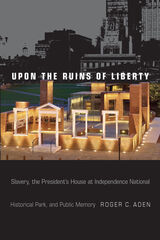
Upon the Ruins of Liberty
Slavery, the President's House at Independence National Historical Park, and Public Memory
Roger C. Aden
Temple University Press, 2014
The 2002 revelation that George Washington kept slaves in his executive mansion at Philadelphia's Independence National Historical Park in the 1790s prompted an eight-year controversy about the role of slavery in America's commemorative landscape. When the President's House installation opened in 2010, it became the first federal property to feature a slave memorial.
In Upon the Ruins of Liberty, Roger Aden offers a compelling account that explores the development of this important historic site and how history, space, and public memory intersected with contemporary racial politics. Aden constructs this engrossing tale by drawing on archival material and interviews with principal figures in the controversy-including historian Ed Lawler, site activist Michael Coard, and site designer Emanuel Kelly.
Upon the Ruins of Liberty chronicles the politically-charged efforts to create a fitting tribute to the place where George Washington (and later, John Adams) shaped the presidency while denying freedom to the nine enslaved Africans in his household. From design to execution, the plans prompted advocates to embrace stories informed by race, and address difficulties that included how to handle the results of the site excavation. As such, this landmark project raised concerns and provided lessons about the role of public memory and how places are made to shape the nation's identity.
In Upon the Ruins of Liberty, Roger Aden offers a compelling account that explores the development of this important historic site and how history, space, and public memory intersected with contemporary racial politics. Aden constructs this engrossing tale by drawing on archival material and interviews with principal figures in the controversy-including historian Ed Lawler, site activist Michael Coard, and site designer Emanuel Kelly.
Upon the Ruins of Liberty chronicles the politically-charged efforts to create a fitting tribute to the place where George Washington (and later, John Adams) shaped the presidency while denying freedom to the nine enslaved Africans in his household. From design to execution, the plans prompted advocates to embrace stories informed by race, and address difficulties that included how to handle the results of the site excavation. As such, this landmark project raised concerns and provided lessons about the role of public memory and how places are made to shape the nation's identity.
[more]
READERS
Browse our collection.
PUBLISHERS
See BiblioVault's publisher services.
STUDENT SERVICES
Files for college accessibility offices.
UChicago Accessibility Resources
home | accessibility | search | about | contact us
BiblioVault ® 2001 - 2024
The University of Chicago Press





